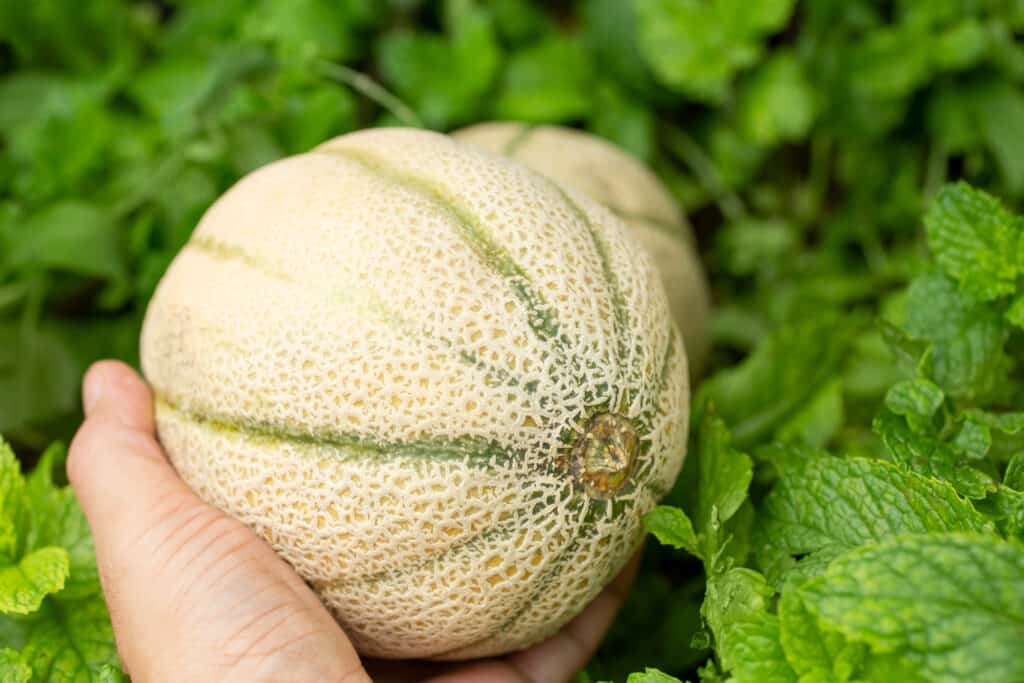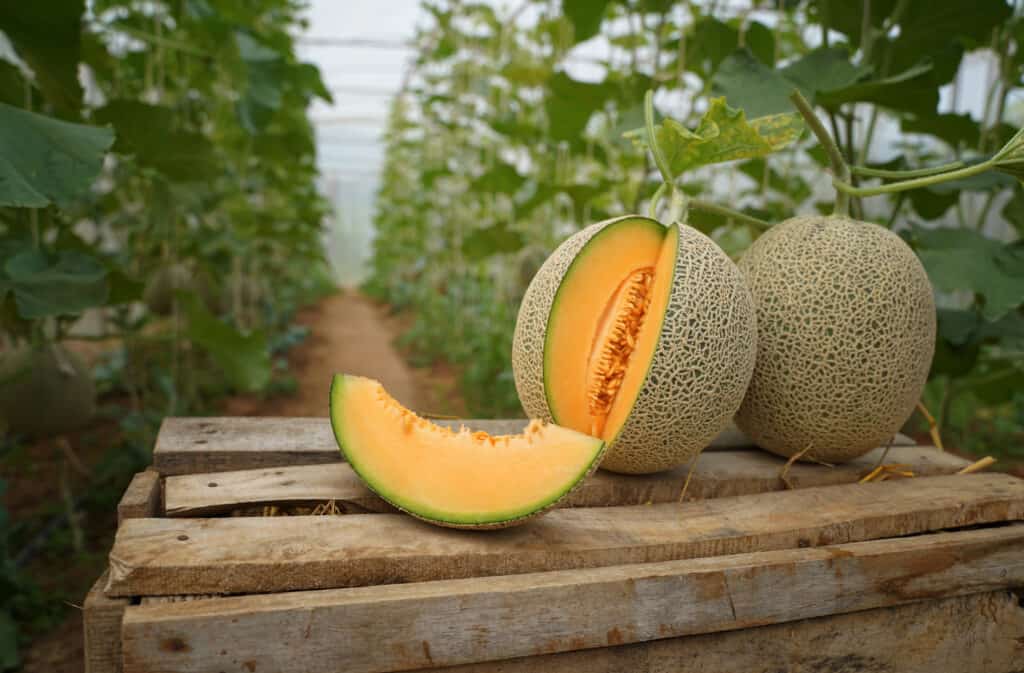When summer rolls around, an abundance of fruit graces the produce section. Mounds of delicious-looking treats, just waiting for someone to eat. And amongst that pile of goodness is the quintessential summer treat: melon. However, these days, there are more varieties available. And they are all worth trying.
This article examines two tasty melons: Tuscan melons (Cucumis melo ‘Tuscan Style’) and cantaloupe (Cucumis melo). Keep reading for summertime inspiration. You may find a new favorite!
Tuscan Melon vs. Cantaloupe: Comparison
Since both varieties are melons, it may get a little confusing. How do you tell them apart? And how do they compare? To help answer these questions, we have developed a handy chart, which you will find below. It breaks down some key characteristics so you can better understand what makes each melon variety unique.
Both Tuscan melon (Cucumis melo ‘Tuscan Style’) and cantaloupe (Cucumis melo) belong to the Cucurbitaceae (gourd) family. However, the Tuscan melon is a cultivar from two Italian melons rather than a distinct species. Overall, the Cucurbitaceae family has 965 species spread out among 95 genera.
Due to their shared lineage, Tuscan melon and cantaloupe have many things in common. But they also have unique attributes. They differ in their origins, size, fruit, and leaf structure. We will look at each in more detail below.
| Tuscan Melon | Cantaloupe | |
|---|---|---|
| Scientific Classification | Cucumis melo ‘Tuscan Style’ | Cucumis melo |
| Common Name(s) | Tuscan Style | Cantaloupe, muskmelon |
| Origins | A hybrid cultivar crafted from Italian melons. | It is native to Northeast Africa. |
| Size | The vines are trailing and will grow up to 60 inches long. | A vining plant that can grow up to 10 feet long. |
| Fruit | They are sometimes round and sometimes oval but always have blunt ends. The fruit’s ribbed, tan surface contrasts with green or yellow stripes. The fruit weighs between 3 and 8 pounds. Its flesh is bright orange and has a single seed cavity. | The lovely fruit is quite sweet. It is relatively small, weighing only 3 or 4 pounds. The fruit has a perfectly round globe shape. And the outer skin is netted, green, and ribbed. Its inner flesh is bright orange. |
| Leaves and Vines | The leaves are long, rough, and dark green. Its long vines grow from a slightly hairy stem. | The leaves are oval and alternate along a hairy stem. Its vines are trailing. |
| Growing Requirements | As a warm-weather plant, it needs plenty of direct sunlight. Direct sow into mounds spaced two feet apart and in rich soil. Amend the soil as needed and keep your plants well-watered. Winter hardy in Zones 4-10. | This warm-weather plant needs ample sun. Plant in rich, well-draining soil that is mounded. It prefers a pH between 6.0 and 7.0. It is a heavy feeder, so will likely need fertilization. Since it sprawls, it will take up a ton of space. You can train them to climb a trellis to save space. Direct sow into the garden in Zones 4-10. |
| Fun Facts | This variety of cantaloupe is significantly sweeter than its relative. | You can roast and eat the seeds, just as you do with pumpkin seeds. |
Tuscan Melon vs. Cantaloupe: Origins
The flavorful Tuscan melon is the new kid on the block. It is a recently developed cultivar. The new variety initially hit stores in Italy as a test run. Once they took off there, the melons made their way stateside.
Alternatively, cantaloupe is the species that inspired the Tuscan melon. It is native to northeast Africa.
Tuscan Melon vs. Cantaloupe: Size
Like its cousins, the Tuscan melon is a trailing vine. It will gladly take over your garden if you let it. The long vines reach between 45 and 60 inches at maturity.
Cantaloupe also grows on long, trailing vines. However, their vines can reach an astounding 10 feet long.
Tuscan Melon vs. Cantaloupe: Fruit
This is where the two melons really differ.
Tuscan melons develop into large, relatively roundish-oval fruits. These melons always sport a distinctive blunt end. They have a tan ribbed exterior surface, offset by striking yellow or green stripes. The fruit weighs between 3 and 8 pounds. And the interior flesh is bright orange and has one small seed cavity. Interestingly, Tuscan melon fruit is significantly sweeter than any of its relatives. It scores a 14 to 16 on the Brix sugar scale.
In contrast, cantaloupes are slightly smaller. They typically only weigh between 3 and 4 pounds at maturity. Each one is globe-shaped and perfectly round. The fruit’s exterior is green, netted, and ribbed. And the sweet interior flesh is bright orange. Cantaloupe has an average Brix score of 11.

Tuscan melons are oval with blunt ends.
©The Image Party/Shutterstock.com
Tuscan Melon vs. Cantaloupe: Leaves
Though they are related, the leaves of Tuscan melons and cantaloupes have slight differences.
The former are dark green, long, and rough. And the vines they cling to are hairy.
However, cantaloupe leaves are usually oval. They are offset, alternating along slightly hairy vines.
Growing Notes
These melons love warm weather. They will thrive in Zones 4-10 if they have the proper growing conditions. The plants need plenty of direct sunlight and do not do well in shaded areas. The soil should be nutritionally rich. But since melons are heavy feeders, you may still want to add fertilizer.
While you can start your melon indoors, they do not transplant well. So wait and directly sow them outside if you can. Build mounds roughly 2 feet in diameter and sow three seeds into the center. Thin down to the strongest seedling when they are a few inches tall.
Because these melons take up a lot of space, you can grow them vertically. Choose a trellis that can support the heavy weight of the fruit and start training the vines upward early.

Cantaloupe can get trained to climb a trellis.
©Attasit saentep/Shutterstock.com
Harvesting Notes
Determining when melons are ripe can be a challenge. After all, you can’t gently squeeze them like you would other fruit. And the old wives tale that recommends knocking on the melon and listening for a hollow sound only works on occasion.
So, how do you tell when your melon is ready to harvest and enjoy?
Tuscan melons will get heavier as they near their peak ripening stage. Additionally, you may smell a lovely fragrance when you inspect your plants. Look for melons whose color has deepened and check for the other two indicators. When a melon is fully ripe, it should pull away from the vine easily.
Cantaloupes develop a slight yellow tint to the tough exterior when they ripen. Additionally, the stem may start to crack where it attaches to the top of the fruit. Feel free to harvest your treat if you see one or both indicators.
Unlike other fruit, melons will not continue to ripen after harvesting. So picking them early and leaving them on your counter will not result in a sweeter fruit.
The photo featured at the top of this post is © Kotcha K/Shutterstock.com
Sources
- Plant Village, Available here: https://plantvillage.psu.edu/topics/cantaloupe/infos
- Specialty Produce, Available here: https://specialtyproduce.com/produce/Tuscan_Style_Cantaloupe_Melon_2606.php
FAQs (Frequently Asked Questions)
Is Tuscan melon healthy?
It is extremely healthy. The sweet food is rich in Vitamins K, C, and A. Additionally, it boasts calcium, Magnesium, zinc, iron, potassium, and copper.
Do melon plants need a trellis?
While they technically do not need a trellis, you can certainly add one if you are short on garden space. Opt for a trellis style that can support the heavy weight of the fruit.
Is cantaloupe a healthy fruit?
Yes, it is healthy. This delicious fruit contains vitamins, minerals, and antioxidants. Additionally, it is a good source of water.
Is cantaloupe good for weight loss?
While it technically is not a weight loss food, per se, it can be helpful. With its nutrient, water, and fiber content, cantaloupe can help you feel full longer. And that, in turn, may help you reduce your total caloric intake.
Thank you for reading! Have some feedback for us? Contact the AZ Animals editorial team.






